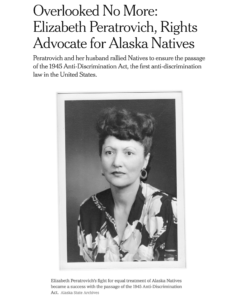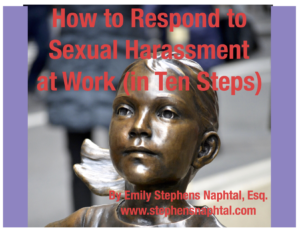Two Civil Rights Reading Recommendations
Are you eager to learn more about civil rights? Check out the following two reads, one short and one long:
Short Read: The New York Times Overlooked No More Obituary for Elizabeth Peratrovich
Have you ever heard of Elizabeth Peratrovich? If not, read up on this fascinating and inspiring woman. The New York Times recently featured her as one of the remarkable people their Obituary section overlooked in years past: https://www.nytimes.com/2019/03/20/obituaries/elizabeth-peratrovich-overlooked.html.
Most people today fairly credit Martin Luther King, Jr. and his cohort with inciting the passage of U.S. anti-discrimination laws. But almost twenty years earlier, Ms. Peratrovich advocated for and won the passage of the country’s very first anti-discrimination law, Alaska’s Anti-Discrimination Act of 1945. Ms. Peratrovich, a Tlingit native, grew up in an Alaskan territory segregated between Whites and Native Americans. She led a many-year campaign to deconstruct this segregation described in the obituary. Today Alaska honors her with Elizabeth Peratrovich Day on February 16th, the anniversary of the passage of the anti-discrimination law. In other areas of the United States, her critical advocacy remains less well known.
Ms. Peratrovich’s story helps show that vital change can begin at the state and local levels. So those of us interested in ensuring civil rights should pay attention to advocacy and politics in our own backyards.
Long Read: Covering: The Hidden Assault on Our Civil Rights by Kenji Yoshino
If you are ready for a longer read, I recommend Kenji Yoshino’s book Covering.
Kenji Yoshino, a constitutional law professor at NYU School of Law, published this insightful book in 2006. Yoshino describes what he means by “covering” in the book’s preface:
“Everyone covers. To cover is to tone down a disfavored identity to fit into the mainstream. In our diverse society, all of us are outside the mainstream in some way […] every reader of this book has covered, whether consciously or not, and sometimes at significant personal cost.” See Yoshino, Kenji. Covering: The Hidden Assault on Our Civil Rights. New York: Random House, 2006. p. ix.
Yoshino illustrates his thesis that covering is the hidden assault on our civil rights by weaving (1) his personal experience as a gay, Japanese-American man, with (2) the history of the unfolding LGBTQ civil rights movement, and (3) then-contemporary cases on civil rights.
Yoshino particularly sees our American “melting pot” culture requiring historically disadvantaged groups to cover their differences. For example,
“[r]acial minorities are pressed to ‘act white’ by changing their names, languages, or cultural practices. Women are told to ‘play like men’ at work. Gays are asked not to engage in public displays of same-sex affection. The devout are instructed to minimize expressions of faith, and individuals with disabilities are urged to conceal the paraphernalia that permit them to function.” See http://kenjiyoshino.com/KY/covering/.
This happens despite the fact that we have agreed to not condone discrimination based on these factors as a society through the passage of anti-discrimination laws.
Progress since Covering’s 2006 Publication, But Room for More
Yoshino’s contention that Courts have overlooked the harms created by covering demands when interpreting anti-discrimination laws was largely true in 2006. Fortunately, in the thirteen years since the book’s publication, cases and laws have begun to address the interrelation between covering demands and discrimination.
At the federal level, a number of cases have affirmed employees’ rights to not cover aspects of their identities related to their protected classes:
- In EEOC v. Abercrombie & Fitch Stores, Inc., 135 S. Ct. 2028 (2015), the Supreme Court required Abercrombie to make an exception to its employee dress code to allow a muslim woman to wear her headscarf while working in its retail store.
- In Young v. United Parcel Serv., Inc., 135 S. Ct. 1338 (2015), the Supreme Court expanded employer duties to accommodate pregnant employees.
- In Zarda v. Altitude Express, Inc., 883 F.3d 100 (2d Cir. 2018), the Second Circuit Court of Appeals held that the federal prohibition of sex discrimination includes discrimination against a person based on their sexual orientation or their open involvement in a same-sex relationship.
At the local level, the New York City Human Rights Commission has increasingly focused on combatting covering requirements as part of its mandate. For example, in February 2019, the Commission released guidance banning discrimination based on hairstyle. In particular it noted that Black New Yorkers cannot be discriminated against for wearing their hair in “locs, cornrows, twists, braids, Bantu knots, fades, Afros and/or . . . in an uncut or untrimmed state.” See https://www1.nyc.gov/assets/cchr/downloads/pdf/Hair-Guidance.pdf.
Despite this progress, I believe we still have a long way to go when it comes to allowing people to bring their full diversity to work and still be included and promoted. Though many corporations today promote diversity and inclusion agendas, they may be too focused on the ethnicity breakdown of their employees and not focused enough on whether those people really feel safe to bring their whole selves to work each day. True diversity and inclusion at work and in public spaces must keep these covering demands in mind.
As Yoshino aptly writes,
“The aspiration of civil rights has always been to permit people to pursue their human flourishing without limitations based on bias.” Covering, at 195.
Being able to identify the phenomenon of “covering” by name is a wonderful step towards promoting this human flourishing. Reading this book will likely inspire you to view authenticity, your own and others’, as a sacred civil and human right.





